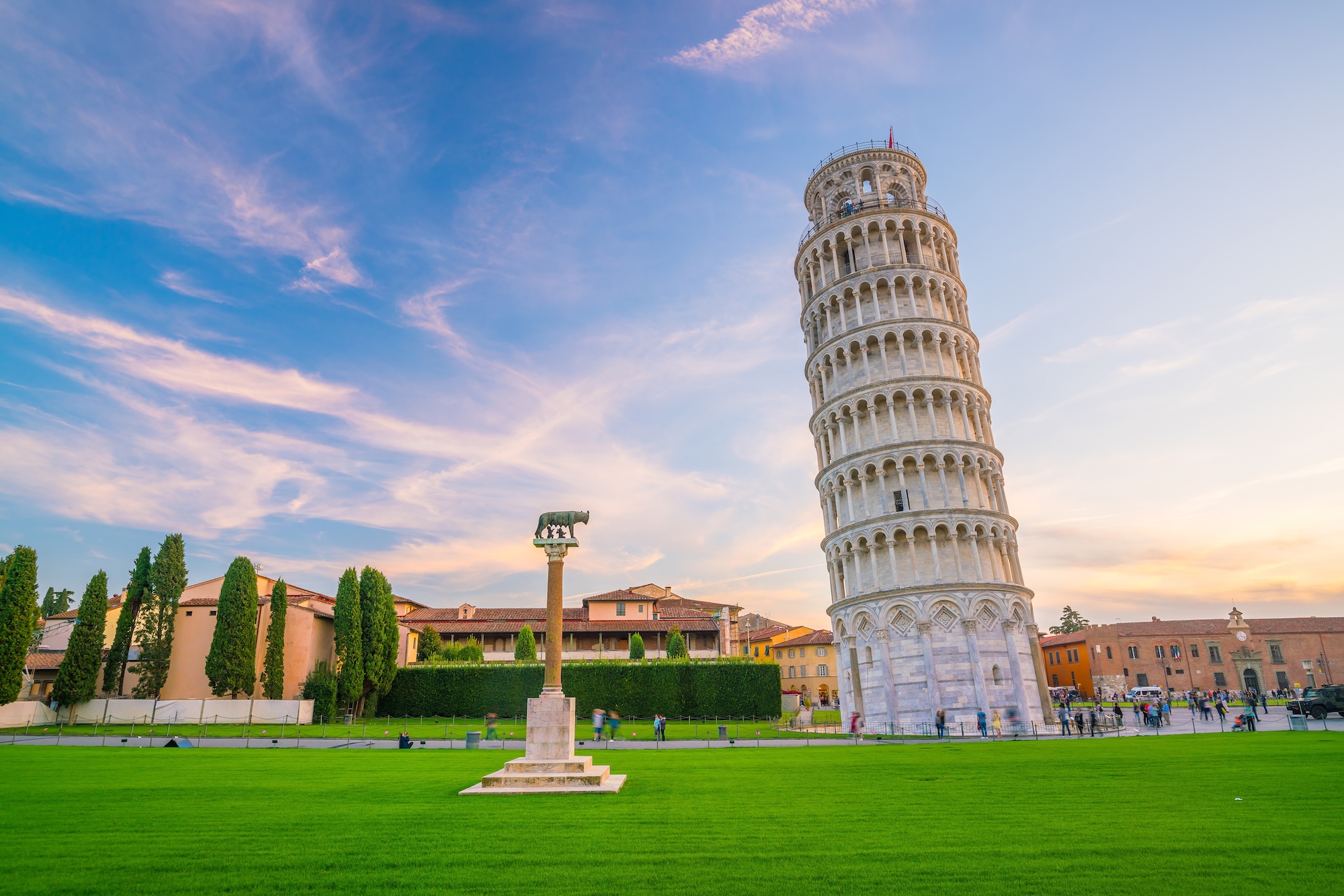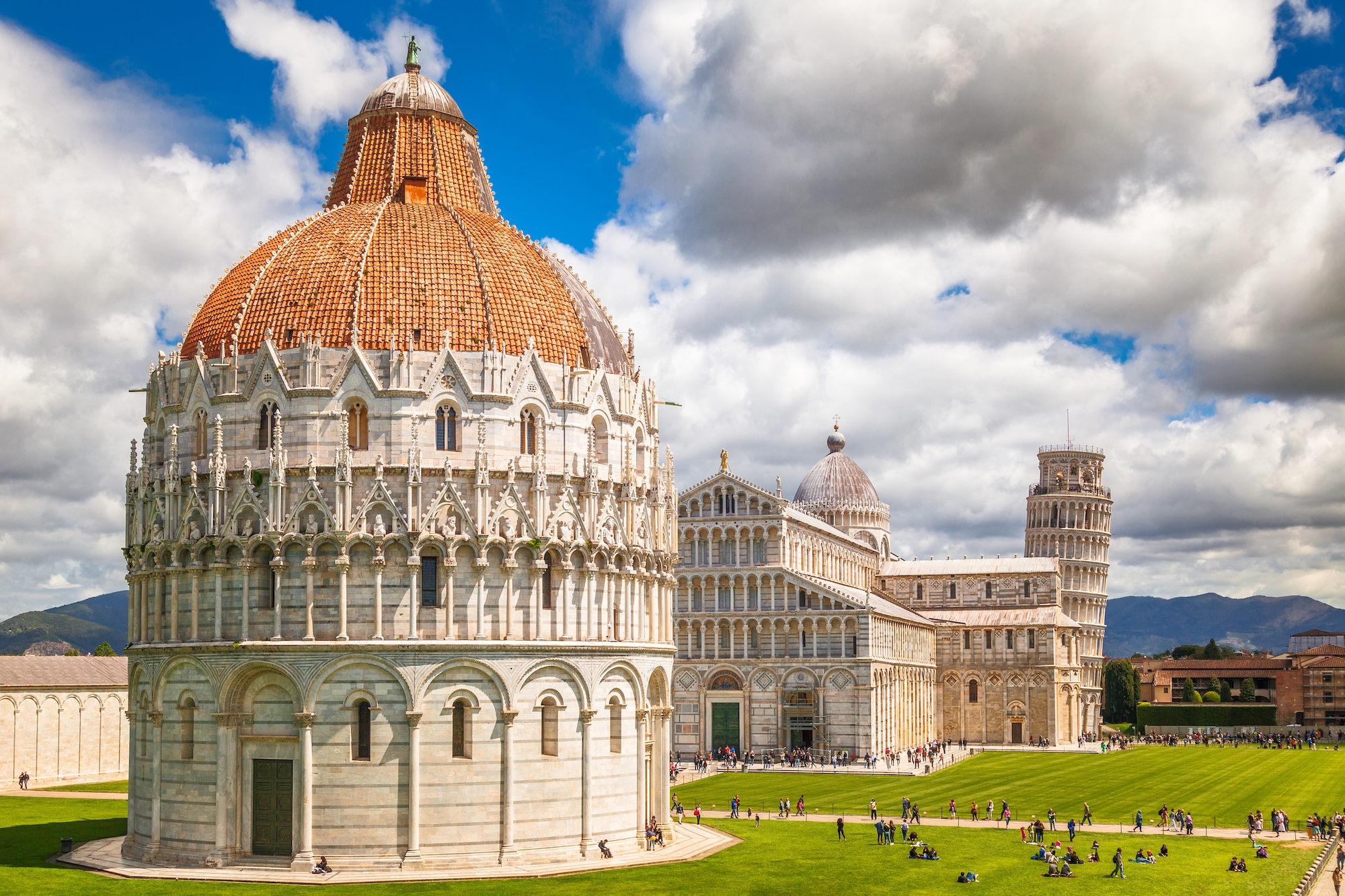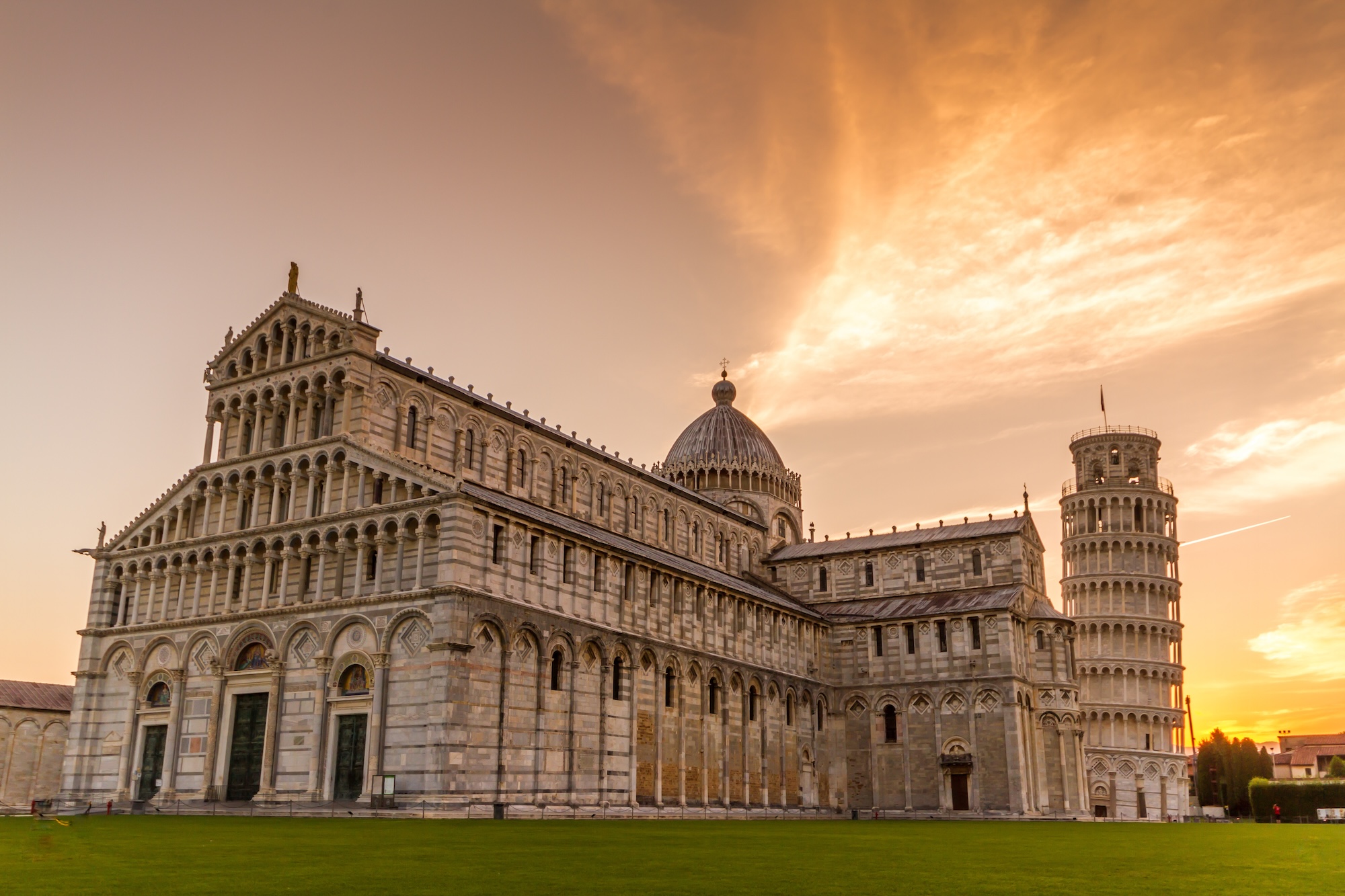
World Travel Tips
What Should You Do in Pisa?
Pisa may be world-famous for its leaning tower, but this charming Tuscan city offers far more than just one iconic sight. With its rich medieval history, vibrant student life, and riverside beauty, Pisa invites travelers to discover architectural marvels, ancient churches, lively piazzas, and hidden gems tucked away in cobbled streets. Here are the top 10 attractions in Pisa every visitor should experience:
1. The Leaning Tower of Pisa

The most recognizable symbol of Pisa, The Leaning Tower of Pisa is an architectural wonder with its distinctive tilt. Built as the cathedral’s bell tower, its unintended lean makes it one of the most photographed landmarks in the world.
Why visit?
Climbing The Leaning Tower of Pisa offers a unique perspective of Pisa and the chance to experience a true icon of Italian architecture. It’s a must-see for anyone visiting Tuscany.
2. Piazza dei Miracoli (Square of Miracles)

A UNESCO World Heritage Site, Piazza dei Miracoli is the heart of Pisa’s historic center, home to the city’s most famous monuments including the Leaning Tower, Cathedral, Baptistery, and Camposanto.
Why visit?
Strolling through Piazza dei Miracoli feels like walking through an open-air museum, surrounded by breathtaking medieval art and architecture.
3. Pisa Cathedral (Duomo di Pisa)

An exquisite example of Romanesque architecture, Pisa Cathedral features intricate marble facades, striking bronze doors, and beautiful mosaics. The interior houses art by renowned Italian masters.
Why visit?
Pisa Cathedral is a masterpiece that reflects the city’s former maritime power and devotion to art and faith.
4. Baptistery of St. John (Battistero di San Giovanni)
Located next to the cathedral, the Baptistery of St. John is the largest in Italy. Its blend of Romanesque and Gothic styles and remarkable acoustics make it a fascinating place to visit.
Why visit?
Climb to the upper galleries of the Baptistery of St. John for unique acoustics and sweeping views over the Piazza dei Miracoli.
5. Camposanto Monumentale (Monumental Cemetery)
This elegant Gothic cloister is adorned with stunning frescoes and houses ancient sarcophagi. Camposanto Monumentale is a peaceful, contemplative space steeped in history.
Why visit?
Exploring the Camposanto Monumentale gives insight into Pisa’s medieval past and artistic heritage.
6. Borgo Stretto
A lively street in Pisa’s historic center, Borgo Stretto is lined with medieval arcades, boutique shops, cafes, and vibrant local life.
Why visit?
Wandering along Borgo Stretto offers a taste of authentic Pisan culture, shopping, and people-watching in a picturesque setting.
7. Santa Maria della Spina
This tiny, jewel-like Gothic church sits right on the banks of the Arno River. Santa Maria della Spina is renowned for its ornate marble facade and delicate sculptures.
Why visit?
Santa Maria della Spina is one of Pisa’s most photogenic and beloved churches, perfect for art and architecture enthusiasts.
8. Piazza dei Cavalieri (Knights’ Square)
Once the political center of medieval Pisa, Piazza dei Cavalieri features grand Renaissance palaces, including the Palazzo della Carovana, designed by Giorgio Vasari.
Why visit?
Piazza dei Cavalieri is a vibrant hub for students and locals, surrounded by beautiful buildings and rich history.
9. Arno River and Lungarni
The Arno River flows through Pisa, lined with elegant palaces and charming bridges. The “lungarni”—walkways along the river—are perfect for an evening stroll.
Why visit?
A walk along the Arno River offers picturesque views and a chance to see Pisa’s colorful facades reflecting in the water, especially at sunset.
10. National Museum of San Matteo (Museo Nazionale di San Matteo)
Housed in a former Benedictine convent, the National Museum of San Matteo boasts an impressive collection of medieval paintings, sculptures, and religious art from Pisa and Tuscany.
Why visit?
Art lovers will appreciate the treasures at the National Museum of San Matteo, providing deeper context to the city’s artistic legacy.
Seasonal Recommendations
☀️ Summer (June–August): Summer is the most popular time to visit Pisa, with lively piazzas, bustling cafés, and a festive atmosphere. Temperatures typically range from 75°F to 90°F (24°C to 32°C), and the long daylight hours are perfect for climbing the Leaning Tower of Pisa, relaxing in Piazza dei Miracoli, or enjoying riverside strolls along the Arno River and Lungarni. Expect larger crowds at major sites and higher accommodation prices, but the city is buzzing with open-air concerts, evening markets, and vibrant local events.
🌸 Spring (March–May): Spring in Pisa brings mild, pleasant weather, with temperatures averaging 55°F to 72°F (13°C to 22°C). The city comes alive with blooming gardens and colorful festivals, making it an ideal time for sightseeing without the peak summer crowds. This is a great season to wander Borgo Stretto for shopping, explore the stunning Pisa Cathedral, or relax at outdoor cafés as students and locals fill the city streets. Spring’s fresh atmosphere and comfortable climate create a welcoming vibe for first-time visitors.
🍁 Autumn (September–November): Autumn is a favorite among frequent travelers for its crisp air, golden light, and smaller crowds. Temperatures usually range from 60°F to 77°F (16°C to 25°C) in early autumn, cooling as winter approaches. It’s a wonderful time to visit attractions like Piazza dei Cavalieri and the National Museum of San Matteo, take scenic photos, and enjoy local food festivals featuring Tuscan specialties. The pace is relaxed, making autumn ideal for soaking in the city’s authentic charm.
❄️ Winter (December–February): Winter is Pisa’s quietest season, with fewer tourists and a peaceful atmosphere. Temperatures generally range from 40°F to 55°F (4°C to 13°C), and occasional rain adds a moody beauty to the city’s medieval streets. While outdoor activities are more limited, it’s a great time to explore indoor sites like the Baptistery of St. John or admire art at the National Museum of San Matteo. Holiday lights and festive markets add cheer in December, while the rest of the season is perfect for travelers seeking a tranquil, reflective experience of Pisa.
Pisa Excursions
Tips for Your Visit
Getting Around
- Walk the City Center: Pisa’s historic center is compact and pedestrian-friendly, making it easy to explore major attractions on foot.
- Use Local Buses: The local bus network (CPT) connects the train station, city center, and main sights efficiently—tickets can be purchased at newsstands or tobacco shops.
- Trains for Day Trips: Pisa Centrale railway station offers convenient train connections for exploring nearby Tuscan cities like Florence and Lucca.
Local Cuisine
- Sample Tuscan Classics: Try traditional dishes such as “cecina” (chickpea flatbread), “ribollita” (vegetable soup), and locally produced pecorino cheese.
- Enjoy Fresh Seafood: Pisa’s proximity to the coast means delicious seafood—look for “cacciucco” (fish stew) at local trattorias.
- Dine in Piazza: Enjoy a meal or aperitivo in lively squares like Borgo Stretto or Piazza dei Cavalieri for a true Pisan experience.
Language
- Italian is Spoken: Italian is the official language, but many people in tourist areas understand basic English—learning a few phrases will be appreciated.
- Politeness Matters: Greet shopkeepers with “Buongiorno” and use “Per favore” (please) and “Grazie” (thank you) for friendly interactions.
Safety
- Watch for Pickpockets: Stay alert and keep an eye on your belongings, especially in crowded areas like Piazza dei Miracoli and on public transport.
- Use Official Taxis: If you need a taxi, use official ranks or reputable apps to avoid unlicensed vehicles.
- Emergency Numbers: In case of emergency, dial 112 for police, fire, or medical assistance throughout Italy.
These tips will help you make the most of your visit to Pisa, from getting around smoothly to savoring local flavors and staying safe!
3 Popular Restaurants
The restaurant scene in Pisa is a vibrant blend of traditional Tuscan trattorias, cozy family-run osterias, and innovative contemporary dining. Visitors can expect everything from rustic local specialties like cecina and ribollita to fresh seafood and modern Italian fare. Whether you’re seeking a romantic riverside dinner or a casual bite near the Leaning Tower, Pisa offers options to suit every palate.
1. Osteria di Culegna
Location: Via Mercanti, 25, 56127 Pisa PI, Italy View On Map
Cuisine: Tuscan, Italian (Traditional Osteria)
Why It’s Popular: Known for its welcoming atmosphere and authentic Tuscan cuisine, Osteria di Culegna offers fresh, homemade pasta, flavorful local meats, and a carefully curated wine list. The menu changes seasonally, focusing on regional flavors and ingredients. Diners rave about the friendly service and intimate, rustic setting, making it a top pick for those wanting a true taste of Pisa.
2. Ristorante La Buca
Location: Via Massimo D’Azeglio, 6, 56100 Pisa PI, Italy View On Map
Cuisine: Seafood, Italian (Fine Dining)
Why It’s Popular: Situated near the historic heart of Pisa, Ristorante La Buca specializes in refined seafood dishes alongside classic Tuscan recipes. The fresh catch of the day, homemade desserts, and attentive service draw both locals and visitors. Its elegant ambiance and creative approach to regional cuisine make it perfect for a memorable dinner or special occasion.
3. Trattoria S. Omobono
Location: Piazza S. Omobono, 6, 56126 Pisa PI, Italy View On Map
Cuisine: Tuscan, Italian (Casual Trattoria)
Why It’s Popular: Beloved for its casual, friendly vibe and hearty home-style cooking, Trattoria S. Omobono serves classic Tuscan comfort food at great prices. The menu features daily specials, local wines, and favorites like ribollita, pappa al pomodoro, and cecina. Its central location and relaxed charm make it a go-to spot for tourists and Pisa residents alike.
Tips for Dining in Pisa
Pisa is famous for its Leaning Tower, but the city’s food scene is just as delightful—blending rustic Tuscan tradition, fresh seafood, and casual trattorias tucked away in medieval streets. Whether you’re savoring a riverside meal, enjoying street food, or seeking out family-run gems, these tips will help you dine like a local in Pisa.
Important: Pisa Tap Water is Safe to Drink
Tap water in Pisa is generally safe, clean, and perfectly fine to drink—just as in most of Italy. It’s regularly tested and meets high EU standards, though the taste may differ slightly from bottled water due to local minerals.
Tip: Save money and reduce plastic waste by refilling your bottle at your hotel or at public drinking fountains. If you prefer bottled water, it’s widely available, but most restaurants will serve tap water if you ask for “acqua dal rubinetto.” If in doubt about older buildings’ pipes, opt for bottled.
1. Book Ahead for Popular Restaurants
Pisa’s best trattorias and osterias, especially those around Borgo Stretto or Piazza dei Cavalieri, can fill up quickly—particularly for dinner and on weekends.
Tip: Make reservations in advance for highly rated spots or any special meal. For casual lunches, you can usually walk in without a booking.
2. Embrace Pisa’s Local Specialties
Tuscan cuisine reigns in Pisa, with dishes like “cecina” (chickpea flatbread), “ribollita” (hearty vegetable soup), and fresh seafood straight from the nearby coast.
Tip: Don’t miss tasting cecina from a bakery or “pizzeria al taglio.” Order local pecorino cheese or try seafood at traditional trattorias for a true Pisan experience.
3. Lunch is Leisurely, Dinner is Later
Lunch is usually served from 12:30 to 2:30 PM, and dinner typically starts after 7:30 PM. Many restaurants close between lunch and dinner, so plan accordingly.
Tip: If you’re hungry mid-afternoon, look for cafes or bakeries that offer panini, pastries, or snacks.
4. Don’t Overlook House Wine
Most Pisa restaurants offer excellent “vino della casa” (house wine) by the glass, half-liter, or liter. Local Tuscan wines are flavorful and great value.
Tip: Ask for the house red or white—often from nearby vineyards. It pairs perfectly with classic Tuscan dishes.
5. Try an Aperitivo Before Dinner
Locals love to enjoy an aperitivo (pre-dinner drink and snacks) at bars along Borgo Stretto or near the Arno River and Lungarni.
Tip: Order a spritz, Negroni, or glass of prosecco, and enjoy complimentary nibbles like olives, chips, or crostini.
6. Tipping is Not Required, But Appreciated
Service is typically included (“coperto” or “servizio”) in your bill. While tipping isn’t expected, it’s customary to round up or leave some small change for good service.
Tip: If service is outstanding, leave a euro or two. Double-check your bill for a “servizio” charge before tipping.
7. Savor Coffee Like a Local
Coffee culture in Pisa is classic Italian—strong, quick, and often standing at the bar. Cappuccino is for breakfast, while espresso is the rule later in the day.
Tip: Order “un caffè” (an espresso) at the bar for a quick, affordable pick-me-up, or linger at an outdoor table to soak up the atmosphere.
8. Expect to Pay for Bread and Cover
Many restaurants add a small “coperto” (cover charge) per person, which covers bread and table service. This is normal in Pisa and across Italy.
Tip: The “coperto” will be listed on the menu—no need to tip extra just for bread.
9. Explore Pisa’s Street Food
Along with sit-down restaurants, Pisa has plenty of spots for quick bites—think slices of pizza, focaccia, or gelato as you explore the city.
Tip: Grab a slice of cecina or a scoop of artisanal gelato while walking between the Leaning Tower of Pisa and Piazza dei Miracoli.
10. Be Adventurous and Try Small Trattorias
The city is filled with family-run trattorias and osterias offering traditional recipes and warm hospitality—often for a great price.
Tip: Venture beyond the tourist areas and ask locals for their favorites. Some of the best meals are found in hidden side streets or quieter neighborhoods.
Conclusion
Dining in Pisa is an experience to savor—whether you’re sampling street food, enjoying fresh Tuscan cuisine, or sipping wine in a lively piazza. With these tips, you’ll enjoy Pisa’s culinary scene like a local and make every meal a memorable part of your Tuscan adventure. Buon appetito!








